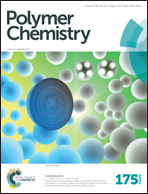Nanoporous polymer particles made by suspension polymerization: spontaneous symmetry breaking in hydrogen bonded smectic liquid crystalline droplets and high adsorption characteristics†
Abstract
A versatile and scalable suspension polymerization method is reported to synthesize nanoporous polymer particles. Detailed insight is obtained into the fabrication of these particles based on hydrogen bonded smectic liquid crystalline monomers. A low viscosity nematic phase is used for emulsification, followed by a cooling step to the high viscosity smectic C phase before polymerization. Upon cooling spontaneous symmetry breaking is observed, resulting in equal quantities of enantiomeric single-domain droplets with either positive or negative tilt of the molecular orientation within the concentric layers. Treatment of the polymerized droplets with base results in nanoporous particles with an onion-like order. Dye adsorption experiments demonstrate a high adsorption capacity in combination with fast adsorption kinetics. The particles and dyes could be easily removed from solution which makes them appealing for separation, purification, and recovery applications.


 Please wait while we load your content...
Please wait while we load your content...